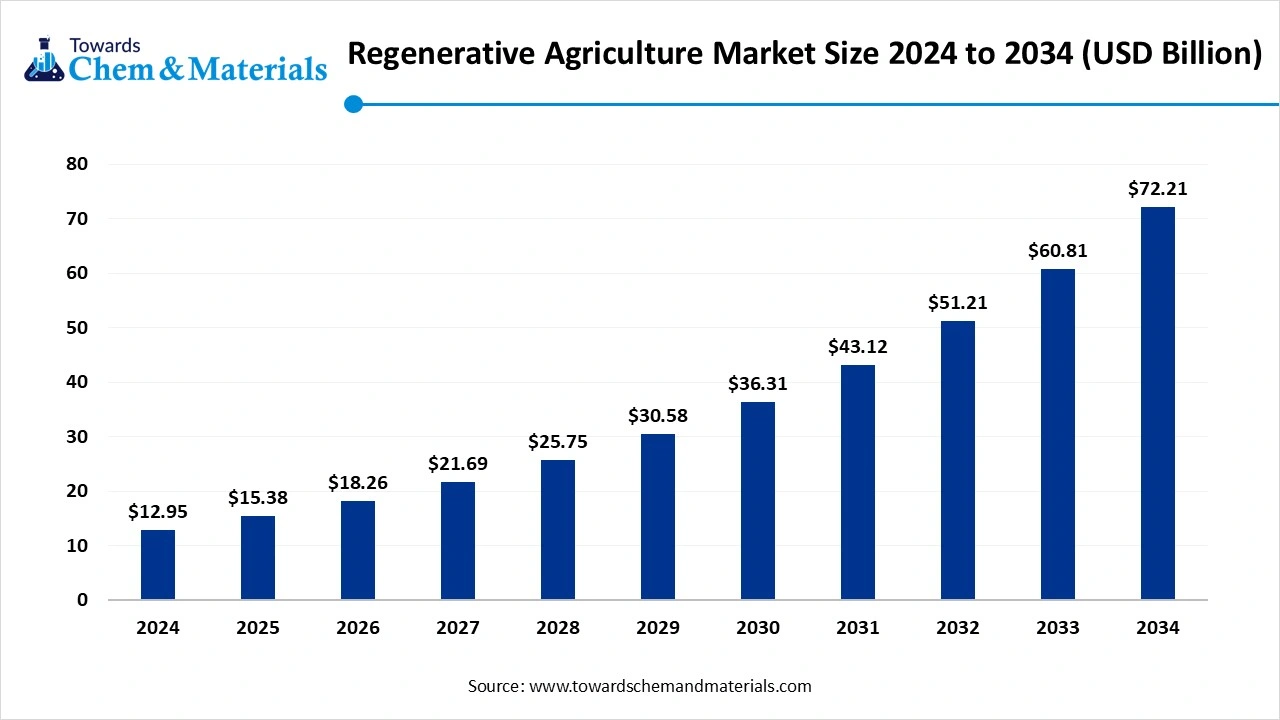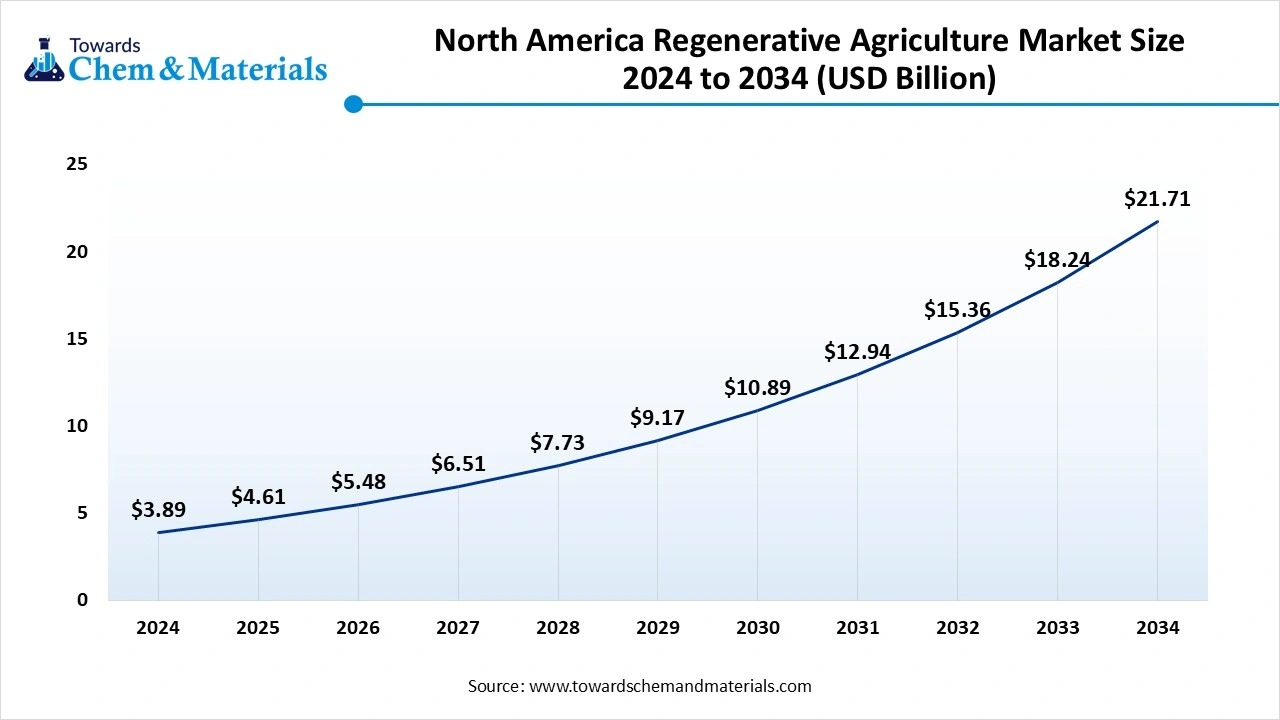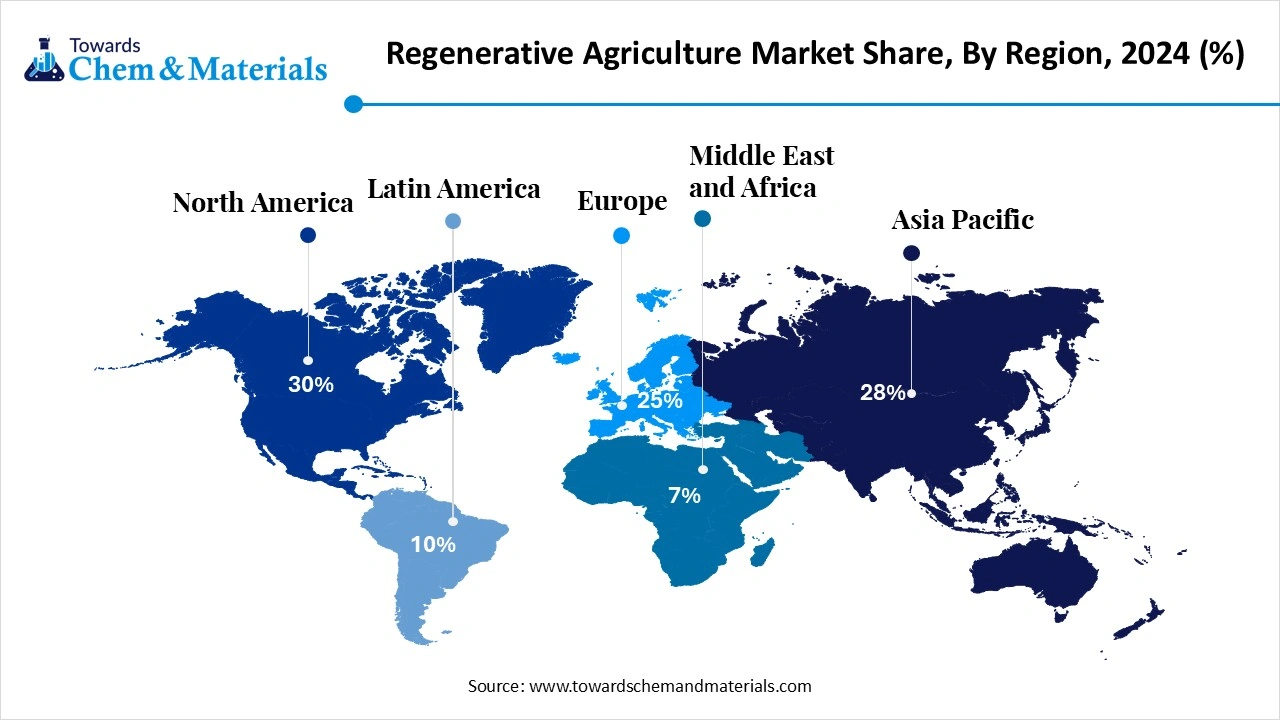November 2025
The regenerative agriculture market size accounted for USD 12.95 billion in 2024 and is predicted to increase from USD 15.38 billion in 2025 to approximately USD 72.21 billion by 2034, expanding at a CAGR of 18.75% from 2025 to 2034. The sudden shift towards repression and sustainable agriculture practices has allowed stakeholders to capitalize on growth outputs in recent years.

The term regenerative agriculture refers to the land management that includes the improvement of soil health, ecosystem enhancing resilience with the production of healthy food, and improvisation of biodiversity. Furthermore, the regenerative agriculture industry has gained major attention in recent years as farmers are seen under the heavy soil restoration and boosting biodiversity in recent years.
| Report Attributes | Details |
| Market Size in 2025 | USD 15.38 Billion |
| Expected Size by 2034 | USD 72.21 Billion |
| Growth Rate from 2025 to 2034 | CAGR 18.75% |
| Base Year of Estimation | 2024 |
| Forecast Period | 2025 - 2034 |
| Dominant Region | North America |
| Segment Covered | By Practice Type, By Products / Manufactured Inputs, By Technology & Tools, By Services & Business Models, By Crop / Production Type, By End-Use Industry, By Region |
| Key Companies Profiled | Great Plains Manufacturing, Inc., Kverneland Group AS , Horsch Maschinen GmbH , Amazone GmbH & Co. KG , Vermeer Corporation , Corteva Agriscience , Bayer CropScience , Syngenta Group , BASF Agricultural Solutions, Novozymes A/S , Marrone Bio Innovations, Inc. , Koppert Biological Systems , Verdesian Life Sciences, LLC , The Andersons, Inc. , Pacific Biochar Solutions , Heliae Development, LLC |
The regenerative agriculture sector is increasingly shifting towards advanced and modern technology like microbiome-first management and others. These management runs on the ArtificiaI Intelligence, low-cost DNA soil testing, and custom microbial consortia as per the recent observation. Also, the technology enables the drone and satellite mapping of the farm areas, which helps farmers to manage their soil programs or agricultural yield concepts in the coming years.
| Country / Region | Regulatory Body | Key Regulations | Focus Areas | Notable Notes |
| United States | U.S. Department of Agriculture (USDA) | Farm Bill (e.g., most recent 2018 bill, with the next expected in 2025) | Climate-smart agriculture and soil health | These agencies are actively observing farming practices |
| European Union | Member State Ministries of Agriculture | Common Agricultural Policy | Biodiversity Enhancement | The agency is responsible for the country’s farming. |
| China | Ministry of Agriculture and Rural Affairs (MARA) | 14th Five-Year Plan (FYP) for National Green Development of Agriculture | Green Agricultural Modernization | The agencies sets a broader strategy of "green agriculture" development. |
| India | Ministry of Agriculture and Farmers Welfare and NITI Aayog | India's New Agricultural Policy 2025 | Farmer Empowerment | These agencies are seen in the promotion of natural and regenerative practices, often without heavy reliance on external inputs. |
How did the Soil Management Segment Dominate the Regenerative Agriculture Market in 2024?
The soil management segment held approximately 35% share of the market in 2024, due to its reflections as the foundation of resilience and long-term productivity. Furthermore, soil management is the first and most prominent step of agriculture, where farmers cover crops, reduce tillage, and compost. Also, modern farms are seen under the heavy usage of technological advancements for the collection of soil data in recent years.
The pest & disease management segment is expected to grow at a notable rate during the predicted timeframe, owing to ongoing climate change incidents and others. Moreover, farmers have been actively shifting to regenerative methods in recent years, including pest and disease management. Furthermore, the major brands are increasingly offering whole pest and disease management premium packages in recent years.
Why does the Fertilizers and Soil Amendments Segment Dominate the Regenerative Agriculture Market?
The fertilizers and soil amendments segment held approximately 30% of the market in 2024 because they deliver visible, short-term improvements in degraded soils. Farmers shifting to regenerative methods often rely on compost, organic amendments, and low-salt mineral fertilizers to rebuild fertility while reducing synthetic inputs.
The biologics and bio stimulants segment is expected to grow at a notable rate during the predicted timeframe, because they activate soil biology instead of just feeding it. Microbial inoculants, mycorrhizae, and enzyme-based products directly enhance soil microbial networks, making nutrient cycles more self-sustaining.
How Did The Data Platforms & Analytics Tools Segment Dominate The Regenerative Agriculture Market In 2024?
The data platforms & analytics tools segment dominated the market with a approximately 40% share in 2024, because they prove and measure impact. Brands, banks, and carbon markets require digital proof of improved soil health and biodiversity. Satellites, soil testing dashboards, and farm management apps provide transparency, making them the most widely adopted tools today.
The precision application hardware segment is expected to grow at a significant rate during the predicted timeframe, because regenerative farming will rely on site-specific, low-disturbance interventions. Drones, variable-rate seeders, and smart sprayers allow targeted cover crop seeding, precise biological applications, and minimal soil disruption. As machinery becomes cheaper and integrated with Al, precision hardware will replace broad-scale equipment.
Why does the Advisory & Agronomic Consulting Segment Dominate the Regenerative Agriculture Market?
The advisory & agronomic consulting segment held approximately 30% of the market in 2024 due to regenerative farming requiring knowledge shifts more than product shifts. Farmers transitioning from conventional methods depend on experts for crop rotation design, soil testing interpretation, and financial planning. Unlike traditional input-based models, regenerative systems are highly contextual-what works on one farm may not work on another.
The carbon project development & crediting segment is expected to grow at a notable rate during the predicted timeframe, akin to farmers' need for long-term financial incentives to scale regeneration. Carbon markets and ecosystem service credits turn regenerative outcomes into recurring revenue streams, often exceeding the value of yield premiums.
Why does the Raw Crops Segment Dominate the Regenerative Agriculture Market?
The raw crops segment held approximately 40% of the market in 2024 because they cover the largest global acreage-corn, soy, wheat, and rice are grown across millions of hectares. These systems are also the most degraded by monoculture practices, making them the first targets for regenerative transformation.
Cover crops, reduced tillage, and crop rotation deliver clear benefits in these large-scale systems, while corporate buyers prioritize row crop supply chains for regenerative sourcing.
The horticulture & vegetables segment is expected to grow at a notable rate during the predicted timeframe, because consumer demand for clean, chemical-free, nutrient-rich food is highest in this category. Regenerative practices like composting, polycultures, and natural pest control are easier to showcase in fruits and vegetables, giving brands a strong marketing appeal.
How Did The Food & Beverage Segment Dominate The Regenerative Agriculture Market In 2024?
The food & beverages segment dominated the market with approximately 45% share in 2024, due to brands' need for a secure, sustainable raw material supply. Major global companies like Nestle, PepsiCo, and Danone are embedding regenerative sourcing into their procurement strategies to reduce climate risks and meet net-zero pledges.
The retail and CPG brands segment is expected to grow at a significant rate during the predicted timeframe, because consumer-facing companies need regenerative credibility. Unlike bulk food producers, retailers sell directly to end consumers, who increasingly demand climate-positive labels. CPG brands will integrate regenerative sourcing into product marketing, certifications, and packaging to build brand loyalty.
North America Regenerative Agriculture Market Size, Industry Report 2034
The North America regenerative agriculture market size was estimated at USD 3.89 billion in 2024 and is projected to reach USD 21.71 billion by 2034, growing at a CAGR of 18.76% from 2025 to 2034. North America dominated the regenerative agriculture market in 2024.

owing to enlarged corporate demand and large-scale farming. Also, the region has benefited from access to the latest agricultural technology, which provides confidence to investors in these large-scale sectors nowadays.
What Drives the United States’s Supremacy in Regenerative Agriculture?
The United States maintained its dominance in the market, owing to the country has the most advanced regenerative finance ecosystems in the current period. Also, the country has observed numerous heavy startup programs linked with regenerative agriculture ecosystems, which are likely to create lucrative opportunities for the sector in the coming years.

Latin America Regenerative Agriculture Market Trends
Latin America is expected to capture a major share of the market during the forecast period, akin to the region has vast farmland, diverse climates, and long-standing agricultural traditions that make it suitable for regenerative practices. Countries like Brazil and Argentina are global leaders in soybean, coffee, and beef production, and farmers are adopting regenerative techniques to improve soil health, reduce deforestation impact, and meet export market sustainability demands.
By Practice Type
By Products / Manufactured Inputs
By Technology & Tools
By Services & Business Models
By Crop / Production Type
By End-Use Industry
By Region
November 2025
November 2025
November 2025
November 2025